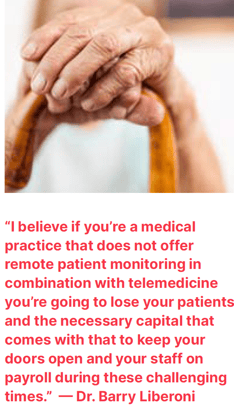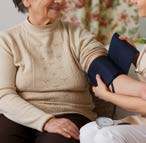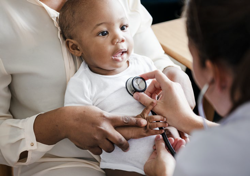Addressing a growing need for virtual senior care at home, remote patient monitoring or RPM provides longitudinal patient health data in real-time, crucial for managing care for patients with chronic conditions.
Most seniors suffer at least one chronic condition1, have limited financial resources2, and significant technology barriers3, making it difficult for them to get care when they need it. Providing care to this population, by monitoring and treating their chronic conditions, is critical for their health and our healthcare system. If their conditions, such as diabetes, obesity, and congestive heart failure4, become unmanaged, it can result in potentially catastrophic and expensive outcomes, further stressing the healthcare system.
Addressing a growing need to serve seniors at home, virtual care, including telemedicine and remote patient monitoring, has come to the forefront as an effective method of managing chronic conditions of seniors and improving outcomes.
what is telemedicine?
Telemedicine encompasses two-way, real-time communication between patients and healthcare providers, including phone conversations, video, and chat5. There are various telemedicine software and technology that make electronic consultations, real-time interactions between providers and patients. With recent technological innovation in telemedicine industry, many healthcare providers are starting to adopt videoconferencing for care management, diagnosis, counseling, and monitoring of patients.
Click here to Read how one Practice uses Telemedicine to improve Care Delivery
What is remote patient monitoring?
Remote patient monitoring (RPM) is a technology platform that enables healthcare providers to monitor patients’ health outside of physical clinic locations. Remote patient monitoring allows physicians to view continuous patient health data and improve patient outcomes by preemptively managing patient care before episodic care events occur. Through an RPM platform, physicians can prescribe health monitoring devices such as a blood pressure monitor, blood glucose meter, digital scale, pulse oximeter, and thermometers
RPM is primarily used for patients with chronic conditions such as diabetes, heart conditions, and hypertension. Whenever the patients use their RPM devices, providers will receive patient health data and population health alerts which provide real-time information about when at-risk patients’ results are out of a defined range. Additionally, in 2019, Medicare introduced reimbursement for remote patient monitoring, making it zero-cost to seniors with at least one chronic condition to access the services.
What role does RPM play in telemedicine care?
While telemedicine eliminates the barriers of transportation and distance, telemedicine on its own just covers a virtual conversation between a healthcare expert and patient about past health data and described symptoms. RPM data and population health alerts on the other hand provide real-time information about when at-risk patients’ results are out of a defined range to allow practitioners to rapidly intervene and the facts necessary to have an informed patient appointment. To fully utilize telemedicine consultation, physicians need data about their patients’ conditions to understand who needs to be attended to and who needs intervention. Remote patient monitoring provides that missing data to better inform providers to provide optimal care for their patients. The real-time patient data informs a telemedicine visit and assists healthcare providers in ensuring a patient is in compliance - all without an office visit. Especially during the COVID-19 pandemic, Remote Patient Monitoring (RPM) has come to the forefront as an effective method of maintaining social distancing protocols while providing necessary care to an at-risk senior population. Physically going into a doctor’s office or downloading complicated smartphone applications to manage their health at home is especially challenging for this population. The combination of telemedicine and remote patient monitoring minimizes the chance of their patients coming into contact with someone infected with COVID-19 outside their home.
Click here to Learn how one Provider uses RPM to Thrive during the COVID-19 Pandemic
Remote Patient Monitoring (RPM) Solutions Providers
 Remote patient monitoring has become more sophisticated in recent years. Technology and devices being used are more innovative than they used to be. For example, 100Plus offers a comprehensive RPM solution that enables providers to receive patient health data as a fully automated charting experience and automated patient health alerts whenever the patient’s data is out of the normal range. They send the monitoring hardware directly to the patients all set up with cellular capability so patients just have to use the device. Then the data automatically uploads to the provider chart area in the web-based online provider portal. Providers will have access to their provider portal online anytime. 100Plus also sends automatic population health alerts to the providers whenever their patient data is out of the normal range so the providers can check their patient data history and provide the care to avoid costly ER visits. Patients use RPM devices at home or on the go to share health information like blood pressure, weight, and temperature with their healthcare provider. With an RPM platform such as 100Plus, health care providers can reduce episodic care and improve patient care by continuously monitoring high-risk seniors in your population.
Remote patient monitoring has become more sophisticated in recent years. Technology and devices being used are more innovative than they used to be. For example, 100Plus offers a comprehensive RPM solution that enables providers to receive patient health data as a fully automated charting experience and automated patient health alerts whenever the patient’s data is out of the normal range. They send the monitoring hardware directly to the patients all set up with cellular capability so patients just have to use the device. Then the data automatically uploads to the provider chart area in the web-based online provider portal. Providers will have access to their provider portal online anytime. 100Plus also sends automatic population health alerts to the providers whenever their patient data is out of the normal range so the providers can check their patient data history and provide the care to avoid costly ER visits. Patients use RPM devices at home or on the go to share health information like blood pressure, weight, and temperature with their healthcare provider. With an RPM platform such as 100Plus, health care providers can reduce episodic care and improve patient care by continuously monitoring high-risk seniors in your population.
Conclusion
Remote patient monitoring enables providers to serve their patients with chronic conditions such as diabetes, obesity, and congestive heart failure via cellular-connected devices and receive longitudinal data in perpetuity. The output informs a telemedicine visit and assists healthcare providers in ensuring a patient is in compliance – all without an office visit. Remote patient monitoring also alerts providers when patients are out of compliance, enabling a provider to intervene with the goal of avoiding expensive, episodic care – all without an office visit and thus alleviating stress on the health system. Telemedicine on its own solves part of the problem, but remote patient monitoring ensures that practitioners are not flying blind during telemedicine visits. Doctors and other healthcare providers can now have access to real-time patient data to inform their decisions, making virtual care a true reality for seniors at home.
About AVS Medical: AVS Medical has a 25 year history of partnering with leading edge healthcare companies to provide, unique and cost effective technology solutions to help independent practices stay thrive. We've partnered with 100Plus to offer an easy to use RPM platform for your practice and patients.
Are you ready to learn how RPM can help your patient's and your practices revenue stream?
Sources:1 Facts About Healthy Aging. (2018, June 12). Retrieved July 22, 2020, from https://www.ncoa.org/news/resources-for-reporters/get-the-facts/healthy-aging-facts/. 2 Airgood-Obrycki, W., Anderson, C., Baker, K., Chaknis, J., Donahue, K., Flynn, A., . . . Willhttps://www.jchs.harvard.edu/sites/default/files/Harvard_JCHS_Housing_ Americas_Older_Adults_2019.pdf, A. (2019). Housing America’s Older Adults 2019. Retrieved 2020, from https://www.jchs.harvard.edu/sites/default/files/Harvard_JCHS_ Housing_Americas_Older_Adults_2019.pdf 3 Anderson, M., & Perrin, A. (2019, December 31). Barriers to adoption and attitudes towards tech among older Americans. Retrieved July 22, 2020, from https:// www.pewresearch.org/internet/2017/05/17/barriers-to-adoption-and-attitudes-towards-technology/ 4 Facts About Healthy Aging. (2018, June 12). Retrieved July 22, 2020, from https://www.ncoa.org/news/resources-for-reporters/get-the-facts/healthy-aging-facts/ 5 Telemedicine. (n.d.). Retrieved July 22, 2020, from https://www.medicaid.gov/medicaid/benefits/telemedicine/index.htm




